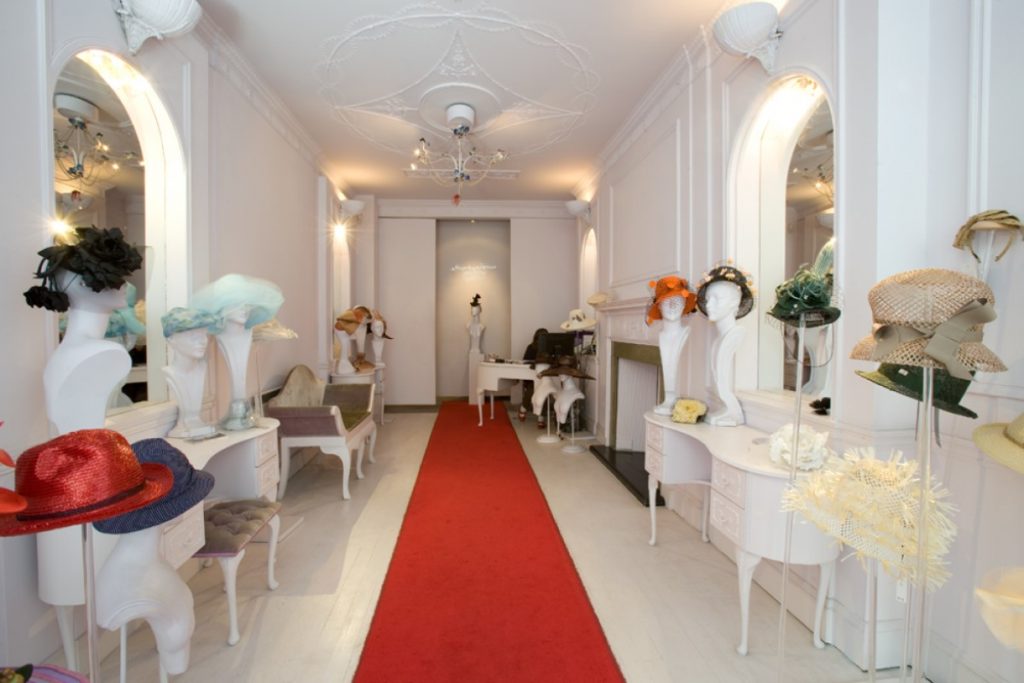Hats: An Anthology by Stephen Jones
This exhibition was a collaboration between the V&A and one of the fashion world’s most prolific milliners, Stephen Jones. It followed in the footsteps of the V&A’s very first fashion show in 1971, ‘Fashion: An Anthology by Cecil Beaton’.
Distinct from hat-making, with its large-scale production of standard hat types, millinery focuses on the creation and decoration of elegant, experimental and often whimsical hats.
This exhibition followed the life-cycle of a hat from its inspiration and creation to the salon and finally to the client who gives the hat its ultimate purpose and flourish.
Cecil Beaton’s 1971 show raised the profile of fashion and put it firmly on the museum map. Stephen Jones felt that the same should be done for what he terms ‘the ultimate accessory’ – the hat.
‘A hat makes clothing identifiable, dramatic and, most importantly, fashion … It’s the cherry on the cake, the dot on the ‘i’, the exclamation mark, the fashion focus. Everyone from showgirls to dictators knows that by wearing a hat they will be centre of attention.’
Stephen Jones
The V&A’s significant hat collection reveals an exciting record of the changes in headgear over the past 17 centuries. While the hats in the collection are usually displayed as part of an ensemble or within an accessories display, this exhibition opened up the archive in much greater depth. Taking the expert viewpoint of a milliner, the exhibition uncovered a rich seam of fashion, style, inspiration, craft and technique inherent in every hat.
Stephen Jones began researching at the V&A’s archives on 2 April 2007. He spent the next year going through cupboards, stores and other museum collections, looking at what amounted to thousands of hats, and as the hats emerged the narrative became apparent. Jones said: ‘The criteria for selecting hats were surprisingly straightforward: a delicious brim line, spectacular detailing, an intriguing provenance, designs that somehow linked past, present and future’.
‘This is my very personal anthology of hats, a mish-mash of dates, places, stories and illusion that are squished into a sense of order by a mad hatter’s logic … It is my own viewpoint of where hats come from, how they are made, where they are sold and the extraordinary people who wear them.’
Stephen Jones
Inspiration
A hat begins life as an idea in the mind of the milliner. Stephen Jones found inspiration from many of the hats in the V&A’s archive.
Historic hats redolent of romance and adventure are a constant source of inspiration for many milliners.
Architecture and geometry, travel and exoticism can all spark the maker’s imagination. The natural world, too – flowers, feathers, the sea, animals and vegetation – offers inspiring forms and styles that can be endlessly updated for new creations.
Hats are unconstrained by the need for fastenings or neck holes, sleeves or soles, opening a door of fashion possibilities.
Creation
The millinery workroom or atelier is the creative laboratory where hat designs are transformed from ideas into reality.
The methods, materials and tools have changed little in the past hundred year. Milliners still work seated around a large table with their scissors, needles and thread.
Straws, felts and fabrics remain the key materials used to pin and shape prototype hats on a calico-covered head known as a ‘poupée’. From these prototypes a hat mould (‘block’) can be taken. Usually of wood, the block is an essential tool of the workroom. Milliners often amass a library of differently shaped blocks that can be used time and time again.
The Salon and the Client
At the beginning of the 20th century, individual milliners turned the simple hat shop into an exclusive space that enhanced their signature styles. This salon environment, similar to that of haute couture dress houses, offered the customer an intimate place to view, try and buy elegantly displayed hats.
Traditionally a good saloniste offered advice, recommending turban styles for those with large noses or advising asymmetric styles to slim a wide face. However, the cardinal rule of hat-buying, as French fashion editor Genevieve Dariaux noted, is to ‘take the one you fall in love with, which mysteriously ‘does something’ for you, which magically makes you feel more beautiful’.
When the right client meets the right hat, the wearing begins. On the hat’s journey – from initial inspiration, through construction, to the salon where it is tried and chosen – it is the client who ultimately gives it life and launches it into the world. From royalty to revolutionaries, a hat frequently becomes a signature feature for a well-known face, recognised as part of the personality of the wearer.
Hats Anthology V&A_press_release
Image © Victoria and Albert Museum, London
